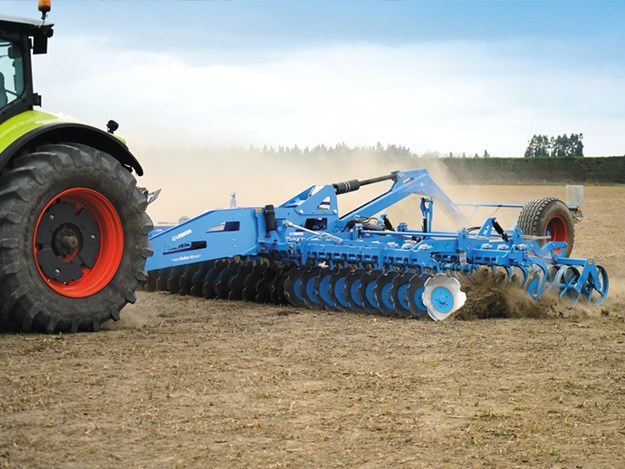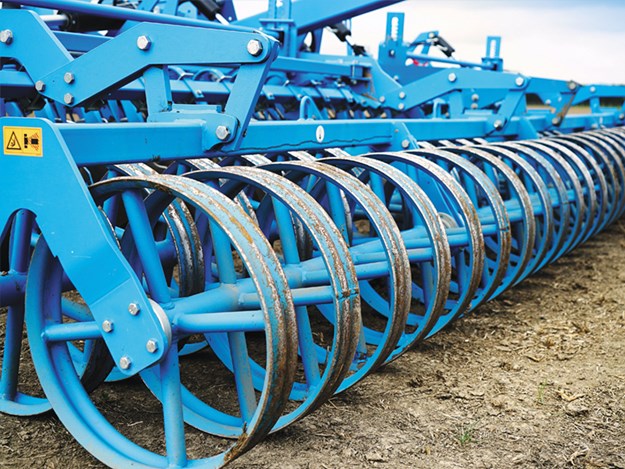Cracking into the congested speed disc market is no easy task. When you take a close look, there is a lot to choose from. Fortunately, Lemken has quite the pedigree in this field (pun intended), having been in the game for an impressive 240 years. From a foundry established by Wilhelmus Lemken in 1780, the brand has grown to become a globally recognised manufacturer of agricultural machinery
 |
|
The soil movement on the first pass despite the concrete like conditions was impressive
|
For our Lemken test experience with EuroAgri, the six-metre Lemken Rubin 10 was set up just out of Ashburton on New Zealand’s South Island, ready to work on an ex-kale dryland paddock, which had a consistency similar to concrete.
The Lemken Rubin 10 is different to most other speed discs in that its large, scalloped discs are mounted individually on cranked, forged steel legs with individual coil springs. This allows it to work down to 14cm and individually ‘jump’ over obstacles – resulting in outstanding trash flow.
 |
|
The Claas 850 provided plenty of power upfront
|
DISC ARRANGEMENT
Another distinguishing feature is that the two gangs of discs are arranged differently on each side of the machine. With 48 discs in total (25cm apart), on the front gang, 11 are placed on one side and 12 on the other side. On the rear, there are 13 on one side and 12 on the other in the opposite arrangement to the front. Confused?
It’s difficult to explain, but essentially the front row chops and throws the soil up, while the back row additionally chops any turf while providing a smoothing effect. The additional disc on the rear gang also neatly brings any soil that has been thrown out from the first row back in line.
The other benefit of having half the row going one way and the another half the other way is that the discs don’t crab and bounce from side to side like some speed discs do in tough conditions (such as the paddock we were working in), resulting in a much smoother paddock.
To test my explaining skills: there’s another anomaly where the centre discs are on larger legs and springs, and both throw the same direction on the front and rear gang but are more offset than the rest. This allows for a perfect working depth across the width of the machine without an uncultivated strip in the middle where the discs join.
That’s a lot to explain (whew!) but, hopefully, once you look at the photos showing the design, it will all make sense.
Also available are outer discs that essentially keep the soil in the machine, similar to the sideboards on a power harrow. The Lemken Rubin machine we trialled wasn’t currently fitted with them due to a delay in shipping, but it does keep things nice and tidy and provides a level finish.
 |
| The large diameter disc on the forged trailing arm with individual disc suspensionThe Claas 850 provided plenty of power upfront |
MAINTENANCE
Made from hardened Duramaxx Steel, the discs are 645mm, with legs angled at 20 degrees. The discs themselves have an angle of 17 degrees on the front and 15 on the back, accompanied by maintenance-free hubs.
The fancy suspension system on the Rubin is taken care of by 15mm springs that essentially work as an auto-reset system. When an obstacle is hit, that single leg pops up and then the compressed spring pushes back down to regain the desired depth. This also takes any unnecessary stress off the frame. While this could be seen as higher maintenance long-term, it definitely provides better contour following across the width of the machine than standard rubber block mounted discs on angled rectangular hollow sections.
The large diameter disc on the forged trailing arm with individual disc suspensionThe Claas 850 provided plenty of power upfront
.jpg) |
|
Easy-to-see depth gauge
|
ADJUSTMENT
Other impressive features are the easily adjustable but cleverly designed rebound harrows (which knock sods back to be re-chopped), as well as the rear levelling, hockey stick-type paddles. A simple turn-handle design with one handle for each side of the machine allows for simple adjustment. For me, this means that operators are more likely to get out and do the adjustment if they don’t have to deal with clips and pins. Additionally, if you have hydraulic rams in place, operators are more likely to play around with it all the time, resulting in an even worse finish across the paddock. I love Lemken’s simple set-and-forget operation. I guess that’s what you’ve got after being in the game for more than 240 years.
The soil-on-soil double roller is adjusted via two rams on each side. Combined with the large drawbar ram at the front, this ensures the machine sits level while working and can be simply adjusted, with a nice, easily readable depth gauge visible from the cab. Optional front gauge wheels are an addition that I think would be great for this machine, and when fitted work in conjunction with the rear roller, it allows perfect working depths across the length of the machine.
The cleverness doesn’t stop there either, with the transport locking system sucking the roller in to keep the transport width just under three metres. The roller also calibrates the system before it’s folded, so once unfolded, it goes back to the previous setting. The transport wheels (550/60 R22.5) provide a well-balanced and stable machine on the road.
The cultivator can either be drawbar mounted (like our test machine) or on a three-point hitch system, with three double-acting spools needed, which look after rear transport wheels, folding and the depth roller.
 |
|
The soil movement on the first pass despite the concrete like conditions was impressive
|
PERFORMANCE
As mentioned earlier, given that the soil was extremely hard, it was mighty impressive that the discs even went in the ground, to be honest. The finished result after two passes was exceptional, given this is labelled as a primary cultivator. I think of primary as ex-crop ground, but the ability to be a secondary machine after a plough or offset discs for ex-tough pasture adds to the machine’s arsenal.
The only thing I didn’t like was the headland turning needs the machine to be lifted onto the transport wheels. For me, lifting onto the roller instead at the headland gives you less soil dumping, and you get the transport wheel marks in the finished product as opposed to the roller, which gives a nice even finish across the width of the machine.
 |
|
The double soil to soil rear roller
|
SUMMARY
Thoughtful, clever design is evident throughout the Lemken Rubin 10. It’s a heavy-duty machine, yet profile cutting high tensile, low weight steel has been used to allow the weight of the machine to provide good soil penetration without the need to drag a large, overly heavy machine, burning diesel and tyres, around.
Given how hard the soil was we were working in, the discs didn’t move around at all, which was impressive given that most speed discs would have been bouncing and moving all over the show. The simple left/right combo on each side is a genius piece of engineering, providing a well-balanced machine with auto reset individual spring discs and large-diameter discs, which ensures this serious bit of kit stands out from the crowd in a busy market.
Lemken machinery is available through dealerships in Queensland, NSW, Victoria and Tasmania.
 |
|
Great aerial shot of the opposing disc gangs on each side of the machine
|
SPECIFICATIONS
Lemken Rubin 10
Recommended HP 210–300hp
Working width 6m
Working depth 140mm
Disc diameter 645mm
Number of discs 48
Machine width 6m
POSITIVES
- Alternate left/right disc combo
- Individually sprung disc legs
- Maintenance-free hubs
- Sleek-looking, well-built machine
- Large rear transport wheels
- Clever yet simple adjustment
- Large diameter discs really chop and move the soil
- Double ‘soil on soil’ roller makes a nice finish
- Easy to see depth adjustment scale
NEGATIVES
- For headland turning, I prefer lifting onto a roller than transport wheels
 |
|
Great view of the opposing disc gangs left and right
|
Photography: Justin Bennett

